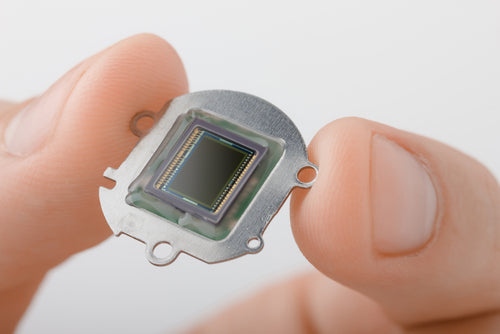Camera Image Sensor sizes are commonly referred to as a fraction of an inch. This can create some confusion for customers as converting the actual fraction to mm and using this as a reference point gets the wrong result. At the same time sensor formats from different or even the same manufacturer which are classed as the same size do not necessarily have the same dimensions! This is problematical when choosing the correct lens for any given sensor format.

In order to understand where the naming convention in inches comes from and why sensor manufacturers still keep to it we have to go back to the beginnings of electronic imaging.
The first sensors for imaging applications were based on video camera tubes (cathode ray tubes). The size of video camera tubes was given as the outer diameter of the glass tube in inches. However this does not reflect the true active (sensitive) area.
A 1” diameter tube has about ⅔ of its diameter as its sensitive area which comes up to ~ 16 mm (see figure 1).
As technology progressed, video camera tubes became less important and were replaced by rectangular solid state sensors. In order to describe the difference in shape the term optical format was introduced.
The optical format refers to the actual diagonal of the sensor multiplied by 1.5. It is a hypothetical measurement and rounded to a convenient fraction of an inch e.g. ½” or ⅓”. Hence a 1” solid state sensor has roughly the same diagonal as a corresponding video tube with 1” diameter (shown in figure 1). Referring to optical formats, one can compare the angle of view a lens would give on a solid state sensor compared to a camera video tube.

Optical formats are not standardised and therefore the dimensions of sensors of the same 1/x” size may vary not just between sensor manufacturers but also within one sensor manufacturer itself. An example for this is CMOSIS who have 1” sensors that can be either square or rectangular in shape and hence differ in their dimensions but are both classed as 1” sensors. New sensors are typically grouped within the closest existing sensor size even if the dimensions differ slightly.
Considering this, it is all the more important when selecting a lens to check for the actual sensor dimensions the lens was designed for and the actual sensor dimensions of the camera that you using to ensure the sensor can be filled completely to avoid vignetting.
If you have questions about the compatibility of a lens and sensor we are here to help, don't hesitate to ask!
Click here to see a constantly updated list of sensors with their optical parameters, with links to cameras in our portfolio that uses those sensors.

